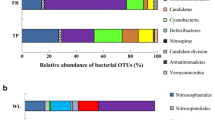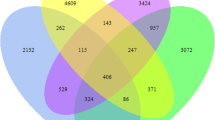Abstract
Purpose
Soil microbial communities can be strongly influenced by agricultural practices, but little is known about bacterial community successions as land use changes. The objective of this study was to determine microbial community shifts following major land use changes in order to improve our understanding of land use impacts on microbial community composition and functions.
Materials and methods
Four agricultural land use patterns were selected for the study, including old rice paddy fields (ORP), Magnolia nursery planting (MNP), short-term vegetable (STV), and long-term vegetable (LTV) cultivation. All four systems are located in the same region with same soil parent material (alluvium), and the MNP, STV, and LTV systems had been converted from ORP for 10, 3, and 30 years, respectively. Soil bacteria and ammonia oxidizer community compositions were analyzed by 454 pyrosequencing and terminal restriction fragment length polymorphism, respectively. Quantitative PCR was used to determine 16S rRNA and amoA gene copy numbers.
Results and discussion
The results showed that when land use was changed from rice paddy to upland systems, the relative abundance of Chloroflexi increased whereas Acidobacteria decreased significantly. While LTV induced significant shifts of bacterial composition, MNP had the highest relative abundance of genera GP1, GP2, and GP3, which were mainly related to the development of soil acidity. The community composition of ammonia-oxidizing bacteria (AOB) but not ammonia-oxidizing archaea was strongly impacted by the agricultural land use patterns, with LTV inducing the growth of a single super predominant AOB group. The land use changes also induced significant shifts in the abundance of 16S rRNA and bacterial amoA genes, but no significant differences in the abundance of archaea amoA was detected among the four land use patterns. Soil total phosphorous, available phosphorous, NO3 −, and soil organic carbon contents and pH were the main determinants in driving the composition of both bacteria and AOB communities.
Conclusions
These results clearly show the significant impact of land use change on soil microbial community composition and abundance and this will have major implications on the microbial ecology and nutrient cycling in these systems, some of which is unknown. Further research should be directed to studying the impacts of these microbial community shifts on nutrient dynamics in these agroecosystems so that improved nutrient management systems can be developed.




Similar content being viewed by others
References
Acosta-Martínez V, Dowd S, Sun Y, Allen V (2008) Tag-encoded pyrosequencing analysis of bacterial diversity in a single soil type as affected by management and land use. Soil Biol Biochem 40:2762–2770
Acosta-Martínez V, Dowd SE, Sun Y, Wester D, Allen V (2010) Pyrosequencing analysis for characterization of soil bacterial populations as affected by an integrated livestock-cotton production system. Appl Soil Ecol 45:13–25
Andrew DR, Fitak RR, Munguia-Vega A, Racolta A, Martinson VG, Dontsova K (2012) Abiotic factors shape microbial diversity in Sonoran Desert soils. Appl Environ Microbiol 78:7527–7537
Bardhan S, Jose S, Jenkins MA, Webster CR, Udawatta RP, Stehn SE (2012) Microbial community diversity and composition across a gradient of soil activity in spruce-fir forest of the southern Appalachian Mountains. Appl Soil Ecol 61:60–68
Bissett A, Richardson AE, Baker G, Thrall PH (2011) Long-term land use effects on soil microbial community structure and function. Appl Soil Ecol 51:66–78
Chen Z, Luo X, Hu R, Wu M, Wu J, Wei W (2010) Impact of long-term fertilization on the composition of denitrifier communities based on nitrite reductase analyses in a paddy soil. Mcirol Ecol 60:850–851
Chen Z, Liu J, We M, **e X, Wu J, Wei W (2012) Differentiated response of denitrifying communities to fertilization regime in paddy soil. Microb Ecol 63:446–459
Chung S, Kong H, Buyer JS, Lakshman DK, Lydon J, Kim SD, Roberts DP (2008) Isolation and partial characterization of Bacillus subtilis ME488 for suppression of soilborne pathogens of cucumber and pepper. Appl Microbiol Biotech 80:115–123
Dimitriu PA, Grayston SJ (2010) Relationship between soil properties and patterns of bacterial β-diversity across reclaimed and natural boreal forest soils. Microb Ecol 59:563–573
Faoro H, Alves AC, Souza EM, Rigo LU, Cruz LM, Al-Janabi SM, Monteiro RA, Baura VA, Pedrosa FO (2010) Influence of soil characteristics on the diversity of bacteria in the Southern Brazilian Atlantic forest. Appl Environ Microbiol 76:4744–4749
Fierer N, Bradford MA, Jackson RB (2007) Toward an ecological classification of soil bacteria. Ecology 88:1354–1364
Fierer N, Lauber CL, Ramirez KS, Zaneveld J, Bradford MA, Knight R (2012) Comparative metagenomic, phylogenetic and physiological analyses of soil microbial communities across nitrogen gradients. ISME J 6:1007–1017
Filip Z (2002) International approach to assessing soil quality by ecologically-related biological parameters. Agric Ecosyst Environ 88:169–174
Garbeva P, van Veen JA, van Elsas JD (2004a) Microbial diversity in soil: selection of microbial populations by plant and soil type and implications for disease suppressiveness. Annu Rev Phytopathol 42:243–270
Garbeva P, van Veen JA, van Elsas JD (2004b) Assessment of the diversity, and antagonism towards Rhizoctonia solani AG3, of Pseudomonas species in soil from different agricultural regimes. FEMS Microbiol Ecol 47:51–64
Hueso S, García C, Hernández T (2012) Severe drought conditions modify the microbial community structure, size and activity in amended and unamended soils. Soil Biol Biochem 50:167–173
Inglett KS, Inglett PW, Reddy KR, Osborne TZ (2012) Temperature sensitivity of greenhouse gas production in wetland soils of different vegetation. Biogeochemistry 108:77–90
Iovieno P, Alfani A, Bååth E (2010) Soil microbial community structure and biomass as affected by Pinus pinea plantation in two Mediterranean areas. Appl Soil Ecol 45:56–63
Jangid K, Williams MA, Franzluebbers AJ, Schmidt TM, Coleman DC, Whitman WB (2011) Land-use history has a stronger impact on soil microbial community composition than aboveground vegetation and soil properties. Soil Biol Biochem 43:2184–2193
Kuramae E, Gamper H, van Veen J, Kowalchuk G (2011) Soil and plant factors driving the community of soil-borne microorganisms across chronosequences of secondary succession of chalk grasslands with a neutral pH. FEMS Microbiol Ecol 77:285–294
Kuramae EE, Yergeau E, Wong LC, Pijl AS, van Veen JA, Kowalchuk GA (2012) Soil characteristics more strongly influence soil bacterial communities than land-use type. FEMS Microbiol Ecol 79:12–24
Lage MD, Reed HE, Weihe C, Crain CM, Martiny JBH (2010) Nitrogen and phosphorus enrichment alter the composition of ammonia-oxidizing bacteria in salt marsh sediments. ISME J 4:933–944
Lauber CL, Hamady M, Knight R, Fierer N (2009) Pyrosequencing-based assessment of soil pH as a predictor of soil bacterial community structure at the continental scale. Appl Environ Microbiol 75:5111–5120
Lee KY, Kong HG, Choi KH, Lee SW, Moon BJ (2011) Isolation and identification of Burkholderia pyrrocinia CH-67 to control tomato leaf mold and dam**-off on crisphead lettuce and tomato. Plant Pathol 27:59–67
Liliensiek A, Thakuria D, Clipson A (2012) Influences of plant species composition, fertilization and Lolium perenne ingression on soil microbial community structure in three Irish grasslands. Microb Ecol 63:509–521
Manici LM, Caputo F, Babini V (2004) Effect of green manure of Pythium spp. Population and microbial communities in intensive crop** systems. Plant Soil 263:133–142
Manlay RJ, Chotte JL, Masse D, Laurent JY, Feller C (2002) Carbon, nitrogen and phosphorus allocation in agro-ecosystems of a West African savanna III. Plant and soil components under continuous cultivation. Agr Ecosyst Environ 88:249–269
Mavrodi OV, Walter N, Elateek S, Taylor CG, Okubara PA (2012) Suppression of Rhizoctonia and Pythium root rot of wheat by new strains of Pseudomonas. Biol Control 62:93–102
Nacke H, Thürmer A, Wollherr A, Will C, Hodac L, Herold N, Schöning I, Schrumpf M, Daniel R (2011) Pyrosequencing-based assessment of bacterial community structure along different management types in German forest and grassland soils. PLoS ONE 6:1–12
Ngosong C, Jarosch M, Raupp J, Neumann E, Ruess L (2010) The impact of farming practice on soil microorganisms and arbuscular mycorrhizal fungi: crop type versus long-term mineral and organic fertilization. Appl Soil Ecol 46:134–142
Nie M, Meng H, Li K, Wan JR, Quan ZX, Fang CM, Chen JK, Li B (2012) Comparison of bacterial and fungal communities between natural and planted pine forests in subtropical China. Curr Microbiol 64:34–42
Nion YA, Toyata K (2008) Suppression of bacterial wilt and fusarium wilt by a Burkholderia nodosa strain isolated from Kalimantan soils, Indanesia. Microbes Environ 24:134–141
Pernes-Debuyser A, Tessier D (2004) Soil physical properties affected by long-term fertilization. Eur J Soil Sci 55:50–512
Rawat SR, Mannisto MK, Bromberg Y, Haggblom MM (2012) Comparative genomic and physiological analysis provides insights into the role of Acidobacteria in organic carbon utilization in Arctic tundra soils. FEMS Microbiol Ecol 82:341–355
Rotthauwe JH, Witzel KP, Liesack W (1997) The ammonia monooxygenase structural gene amoA as a functional marker: molecular fine-scale analysis of natural ammonia-oxidizing populations. Appl Environ Microbiol 63:4704–4712
Sang MK, Kim KD (2012) The volatile-producing Flavobacterium johnsoniae strain GSE09 shows biocontrol activity against Phytophthora capsici in pepper. J Appl Microbiol 113:383–398
Sanguin H, Kroneisen L, Gazengel K, Kyselkova M, Remenant B, Prigent-Combaret C, Grundmann GL, Sarniguet A, Moenne-Loccoz Y (2008) Development of a 16S rRNA microarray approach for the monitoring of rhizosphere Pseudomonas populations associated with the decline of take-all disease of wheat. Soil Biol Biochem 40:1028–1039
Sanhan E, Muyzer G (2008) Diversity and spatio-temporal distribution of ammonia-oxidizing Archaea and bacteria in sediments of the Westerschelde estuary. FEMS Microbiol Ecol 64:175–186
Steenwerth KL, Jackson LE, Calderón FJ, Stromberg MR, Scow KM (2002) Soil microbial community composition and land use history in cultivated and grassland ecosystems of coastal California. Soil Biol Biochem 34:1599–1611
Sun B, Dong ZX, Zhang XX, Li Y, Cao H, Cui ZL (2011) Rice to vegetables: short- versus long-term impact of land-use change on the indigenous soil microbial community. Microb Ecol 62:474–485
Suzuki MT, Taylor LT, DeLong EF (2000) Quantitative analysis of small-subunit rRNA genes in mixed microbial populations via 5′- nuclease assays. Appl Environ Microbiol 66:4605–4616
Ulrich A, Becker R (2006) Soil parent material is a key determinant of the bacterial community structure in arable soils. FEMS Microbiol Ecol 56:430–443
Wagai R, Kitayama K, Satomura T, Fu**uma R, Balser T (2011) Interactive influences of climate and parent material on soil microbial community structure in Bornean tropical forest ecosystems. Ecol Res 26:627–636
Wu MN, Qin HL, Chen Z, Wu JS, Wei WX (2011) Effect of long-term fertilization on bacterial composition in rice paddy soil. Biol Fertil Soils 47:397–405
Yamada T, Imachi H, Ohashi A, Harada H, Hanada S, Kamagata Y, Sekiguchi Y (2007) Bellilinea caldifistulae gen. nov., sp. nov. and Longilinea arvoryzae gen. nov., strictly anaerobic, filamentous bacteria of the phylum Chloroflexi isolated from methanogenic propionate-degrading consortia. Int J Syst Evol Micr 57:2299–2306
Zhang QC, Shamsi IH, Xu DT, Wang GH, Lin XY, Jilani G, Hussain NM, Chaudhry AN (2012) Chemical fertilizer and organic manure inputs in soil exhibit a vice versa pattern of microbial community structure. Appl Soil Ecol 57:1–8
Acknowledgments
This study was supported by the Natural Science Foundation of China (41090282, 41071181) and the Chinese Academy of Sciences (KZCX2-YW-T07).
Author information
Authors and Affiliations
Corresponding author
Additional information
Responsible editor: Yanfen Wang
Electronic supplementary material
Below is the link to the electronic supplementary material.
ESM Fig. s1
Relative abundances of bacterial communities in soils derived from the different land use systems. The relative abundance was estimated from the proportional abundances of the total population. (DOCX 213 kb)
Rights and permissions
About this article
Cite this article
Sheng, R., Meng, D., Wu, M. et al. Effect of agricultural land use change on community composition of bacteria and ammonia oxidizers. J Soils Sediments 13, 1246–1256 (2013). https://doi.org/10.1007/s11368-013-0713-3
Received:
Accepted:
Published:
Issue Date:
DOI: https://doi.org/10.1007/s11368-013-0713-3




